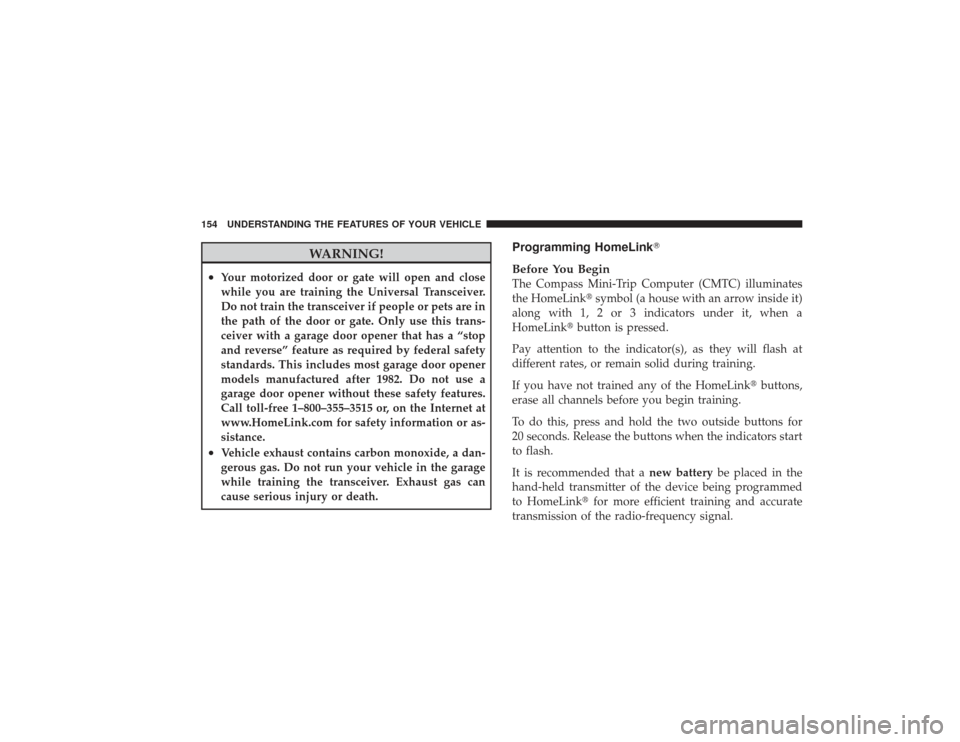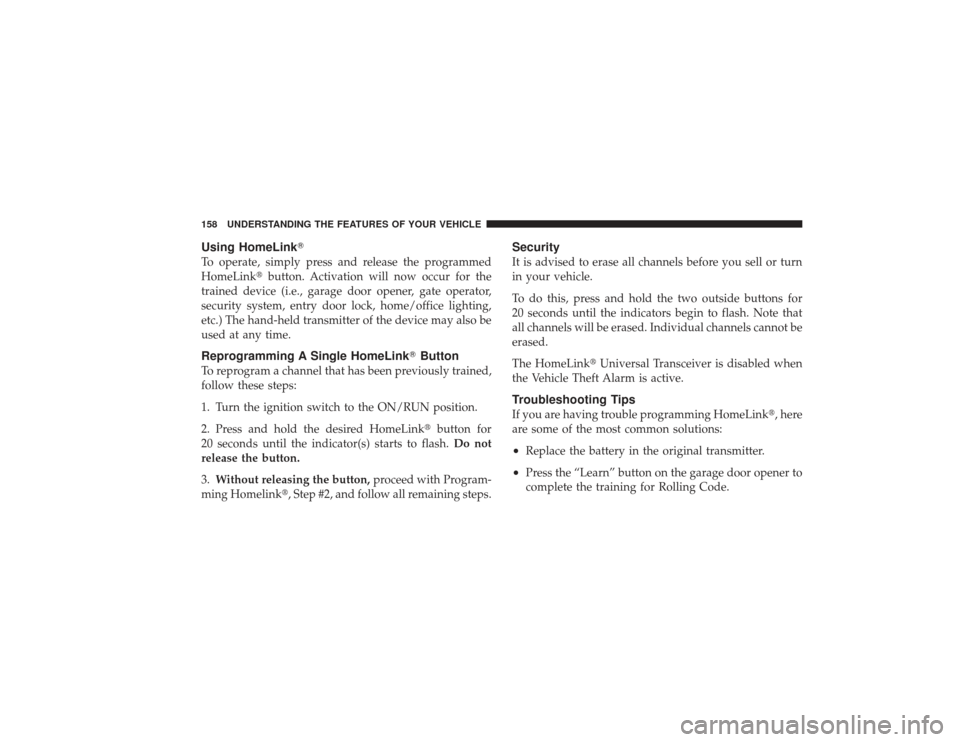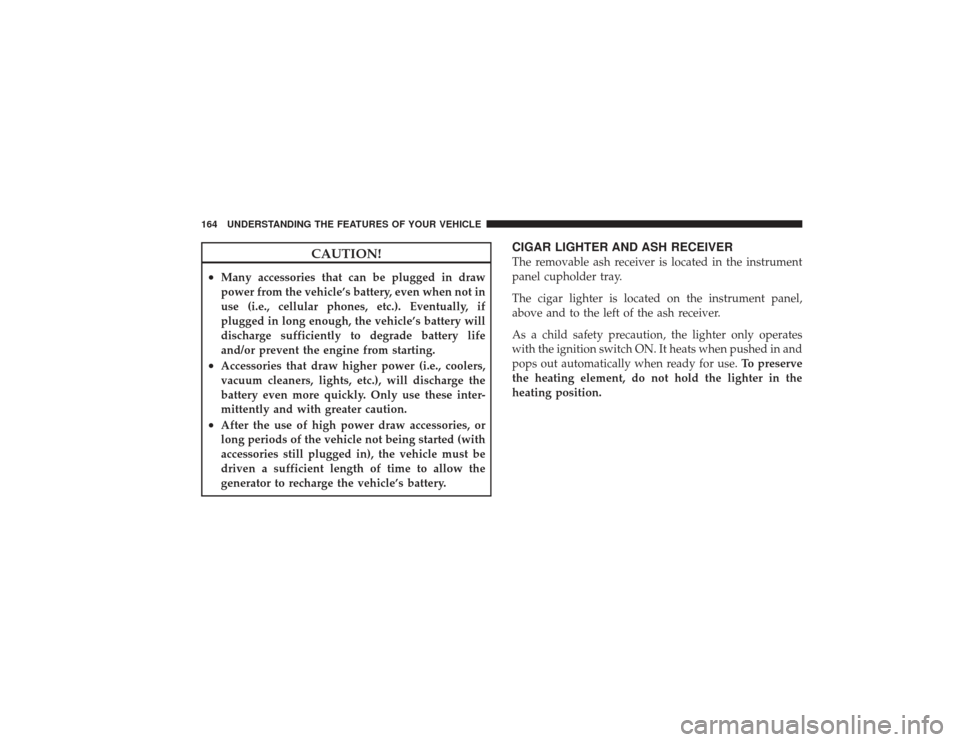Page 134 of 532

LIGHTSThe headlight switch is located on instrument panel to
the left of the steering wheel.Interior LightsCourtesy and dome lights are turned on when the front
doors are opened, when the dimmer control (rotatingwheel on the right side of the switch) is rotated to the
upward detent position, or by pressing the UNLOCK
button on the Remote Keyless Entry (RKE) transmitter (if
equipped).
When a door is open and the interior lights are on,
rotating the dimmer control all the way down to the off
detent will cause all the interior lights to go out. This is
also known as the
�Party�mode because it allows the
doors to stay open for extended periods of time without
discharging the vehicle’s battery.
The brightness of the instrument panel lighting can be
regulated by rotating the dimmer control up (brighter) or
down (dimmer). When the headlights are on you can
supplement the brightness of the odometer, trip odom-
eter, radio and overhead console by rotating the control
up until you hear a click. This feature is termed the
“Parade” mode and is useful when headlights are re-
quired during the day.
Headlight Switch Location
132 UNDERSTANDING THE FEATURES OF YOUR VEHICLE
Page 135 of 532
Battery SaverTo protect the life of your vehicle’s battery, load shedding
is provided for both the interior and exterior lights.
If the ignition is OFF and any door is left ajar, or if the
dimmer control is rotated upwards for approximately
10 minutes, the interior lights will automatically turn off.If the headlights are left on, or turned on, when the
ignition is turned OFF, the headlights will automatically
turn off after approximately eight minutes.
NOTE:
Battery saver mode is cancelled if the ignition is
ON.
Headlight DelayTo aid in your exit, your vehicle is equipped with a
headlight delay that will leave the headlights on for
approximately 90 seconds. This delay is initiated when
the ignition is turned OFF while the headlight switch is
on, and then the headlight switch is cycled off. Headlight
delay can be cancelled by either turning the headlight
switch on then off, or by turning the ignition ON.
Dimmer Control
UNDERSTANDING THE FEATURES OF YOUR VEHICLE 133
3
Page 155 of 532

RESET button approximately five seconds. The last vari-
ance zone number will be displayed. Press the STEP
button to select the new variance zone and press the
RESET button to resume normal operation.Outside TemperatureBecause the ambient temperature sensor is located under
the hood, engine temperature can influence the displayed
temperature, therefore, temperature readings are slowly
updated when the vehicle speed is below 20 mph
(30 km/h) or during stop and go driving.GARAGE DOOR OPENER — IF EQUIPPEDHomeLink�replaces up to three remote controls (hand-
held transmitters) that operate devices such as garage
door openers, motorized gates, lighting, or home security
systems. The HomeLink� unit operates off of your vehi-
cle’s battery. The HomeLink�
buttons are located in the overhead
console, and contain one, two, or three dots/lines desig-
nating the different HomeLink� channels.
NOTE: HomeLink� is disabled when the Vehicle Theft
Alarm is active.
HomeLink Buttons
UNDERSTANDING THE FEATURES OF YOUR VEHICLE 153
3
Page 156 of 532

WARNING!
•
Your motorized door or gate will open and close
while you are training the Universal Transceiver.
Do not train the transceiver if people or pets are in
the path of the door or gate. Only use this trans-
ceiver with a garage door opener that has a “stop
and reverse” feature as required by federal safety
standards. This includes most garage door opener
models manufactured after 1982. Do not use a
garage door opener without these safety features.
Call toll-free 1–800–355–3515 or, on the Internet at
www.HomeLink.com for safety information or as-
sistance.
•
Vehicle exhaust contains carbon monoxide, a dan-
gerous gas. Do not run your vehicle in the garage
while training the transceiver. Exhaust gas can
cause serious injury or death.
Programming HomeLink�
Before You BeginThe Compass Mini-Trip Computer (CMTC) illuminates
the HomeLink� symbol (a house with an arrow inside it)
along with 1, 2 or 3 indicators under it, when a
HomeLink� button is pressed.
Pay attention to the indicator(s), as they will flash at
different rates, or remain solid during training.
If you have not trained any of the HomeLink� buttons,
erase all channels before you begin training.
To do this, press and hold the two outside buttons for
20 seconds. Release the buttons when the indicators start
to flash.
It is recommended that a new batterybe placed in the
hand-held transmitter of the device being programmed
to HomeLink� for more efficient training and accurate
transmission of the radio-frequency signal.
154 UNDERSTANDING THE FEATURES OF YOUR VEHICLE
Page 157 of 532

Your vehicle should be parked outside of the garage
while training.
1. Turn the ignition switch to the ON/RUN position.
2. Place the hand-held transmitter 1 to 3 inches (3 to
8 cm) from the HomeLink�buttons while keeping the
HomeLink� display in view.
For optimal training, point the battery end of the hand-
held transmitter away from the HomeLink�.
3. Simultaneously, press and hold both the chosen
HomeLink�button and the hand-held transmitter button
until the indicator(s) change from a slow to a rapid flash
rate.
Then release both the HomeLink� and hand-held trans-
mitter buttons.
It may take up to 30 seconds or longer in rare cases. The
garage door may open and close while you train. If the signal is too weak to train, replace the battery in the
original hand-held transmitter.
NOTE:
Some gate operators and garage door openers
may require you to replace Step #3 with procedures
noted in the “Gate Operator/Canadian Programming”
section.
4. Press and hold the just-trained HomeLink� button. If
the indicator(s) blink rapidly for two seconds and then
remains constant, continue with the next section: “Pro-
gramming A Rolling Code System”.
NOTE: After training a HomeLink� channel, if the
garage door does not operate with HomeLink� and the
garage door opener was manufactured after 1995, the
garage door opener may have rolling code. If so, proceed
to the heading, “Programming A Rolling Code System.”
UNDERSTANDING THE FEATURES OF YOUR VEHICLE 155
3
Page 160 of 532

Using HomeLink�To operate, simply press and release the programmed
HomeLink�button. Activation will now occur for the
trained device (i.e., garage door opener, gate operator,
security system, entry door lock, home/office lighting,
etc.) The hand-held transmitter of the device may also be
used at any time.Reprogramming A Single HomeLink �ButtonTo reprogram a channel that has been previously trained,
follow these steps:
1. Turn the ignition switch to the ON/RUN position.
2. Press and hold the desired HomeLink� button for
20 seconds until the indicator(s) starts to flash. Do not
release the button.
3. Without releasing the button, proceed with Program-
ming Homelink�, Step #2, and follow all remaining steps.
SecurityIt is advised to erase all channels before you sell or turn
in your vehicle.
To do this, press and hold the two outside buttons for
20 seconds until the indicators begin to flash. Note that
all channels will be erased. Individual channels cannot be
erased.
The HomeLink� Universal Transceiver is disabled when
the Vehicle Theft Alarm is active.Troubleshooting TipsIf you are having trouble programming HomeLink�, here
are some of the most common solutions:•
Replace the battery in the original transmitter.
•
Press the “Learn” button on the garage door opener to
complete the training for Rolling Code.
158 UNDERSTANDING THE FEATURES OF YOUR VEHICLE
Page 165 of 532
There is also a power outlet located on the rear of the
center console (if equipped with bucket seats).
The power outlet(s) has/have a fused direct feed from
the battery so it/they receive power whether the ignition
is ON or OFF.All accessories connected to this/these power outlet(s)
should be removed or turned off when the vehicle is not
in use to protect the battery against discharge.
NOTE:
If desired, all of the power outlets can be
converted by your authorized dealer to provide power
with the ignition switch in the ON position only.
WARNING!
To avoid serious injury or death:•
Do not use a three-prong adapter.
•
Do not insert any objects into the receptacles.
•
Do not touch with wet hands.
•
Close the lid when not in use and while driving
the vehicle.
•
If this outlet is mishandled, it may cause an
electric shock and failure.
Rear Power Outlet
UNDERSTANDING THE FEATURES OF YOUR VEHICLE 163
3
Page 166 of 532

CAUTION!
•
Many accessories that can be plugged in draw
power from the vehicle’s battery, even when not in
use (i.e., cellular phones, etc.). Eventually, if
plugged in long enough, the vehicle’s battery will
discharge sufficiently to degrade battery life
and/or prevent the engine from starting.
•
Accessories that draw higher power (i.e., coolers,
vacuum cleaners, lights, etc.), will discharge the
battery even more quickly. Only use these inter-
mittently and with greater caution.
•
After the use of high power draw accessories, or
long periods of the vehicle not being started (with
accessories still plugged in), the vehicle must be
driven a sufficient length of time to allow the
generator to recharge the vehicle’s battery.
CIGAR LIGHTER AND ASH RECEIVERThe removable ash receiver is located in the instrument
panel cupholder tray.
The cigar lighter is located on the instrument panel,
above and to the left of the ash receiver.
As a child safety precaution, the lighter only operates
with the ignition switch ON. It heats when pushed in and
pops out automatically when ready for use.To preserve
the heating element, do not hold the lighter in the
heating position.
164 UNDERSTANDING THE FEATURES OF YOUR VEHICLE